Free and exclusive discount codes for hundreds of tours and & travel services in Iceland
Subscribe to instantly receive discount codes for tours, car rental, camper van rental, and outdoor clothing rental. Thank you! ❤️ Jon Heidar, Editor of Stuck in Iceland Travel MagazineIcelanders have their version of Santa Claus. Actually, we have thirteen versions of Santa Claus. Yes! Iceland has thirteen Santa Clauses, called Yule lads (‘Jólasveinar’ in Icelandic). The global trend of gentrification has caught up with them, and now they are a delight to children. However, as we will see, the Icelandic Yule was celebrated by terrible trolls who terrified children. But these days, they each arrive in the realm of men on their special day before Christmas. They give kids fun little knick-knacks in their shoes placed by open windows. This is nice, especially for parents who can convince their children to go to bed early so the Yule Lad can give them a treat, which they deposit in the shoes. Please note that the images of the Icelandic Yule Lads are by the Icelandic artist Ólafur Pétursson.
The Icelandic Yule lads come from a dysfunctional family
The Icelandic Yule lads were bad to the bone; they were an essential element of what made Icelandic Christmas so terrifying for Icelandic children in the past. Their parents are the awful troll Gryla, a troll who loves to snatch, cook, and eat naughty children to feed her lazy troll of a husband, Leppaludi. Their pet was the ‘Yule Cat‘ – a horrible monster that would come and kill those who did not have a new piece of clothing for Christmas. This legend of the Yule Cat is why I always buy new clothes for Yule. Otherwise, I worry that the damned cat will catch me and tear me to pieces. Icelandic Christmas is indeed a scary time.
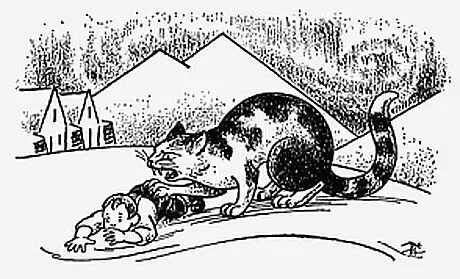
Icelandic past is dark, even at Christmas
The first mention of “Yule lads” is from the 16th century. Their parents have an older history, perhaps before Christianity became Iceland’s official religion in 1000 CE. Initially, the numbers, natures, and names of those miscreants varied. Their names and numbers depended on where you were in Iceland. The total number of names for “Yule lads” recorded is around 70. With time, there was a general agreement that those horrible trolls were ‘only’ thirteen. These days, they are quite nice and are a joy to Icelandic children before Christmas. But in Iceland, the past is a time of abject poverty, starvation, disease, cataclysmic eruptions, darkness, and terrible weather. The best way to understand the legend of the malicious Yule lads, their parents, and their obnoxious cat is to see them in that context.
Meet the Thirteen Yule Lads
They would start to show up at the isolated farms around the country, one by one, thirteen days before Christmas, and cause all sorts of trouble. Each arrived on a specific night, stayed for thirteen days, and then departed the day after Christmas. Here’s the complete roster of these once-terrifying, now-beloved Christmas characters:

1. Stekkjastaur (Sheep-Cote Clod) – December 12
The first one to arrive was Stekkjastaur (Enclosure Post or Sheep-Cote Clod). He had stiff legs, so his gait was unusual – imagine a troll stumbling stiffly through the snow toward your farm. This disabled “Yule lad” was despised as he made it his habit to suck the milk directly from the udders of cows. In the context of historical Iceland, this was an absolutely heinous crime. Milk was precious – a vital source of nutrition during the brutal winter months. Every drop counted when you were barely surviving until spring. By harassing farm animals and stealing milk, Stekkjastaur literally took food from the mouths of babes. The farmers would hear strange noises in the night and know that this wooden-legged menace had arrived to kick off thirteen nights of Christmas chaos.
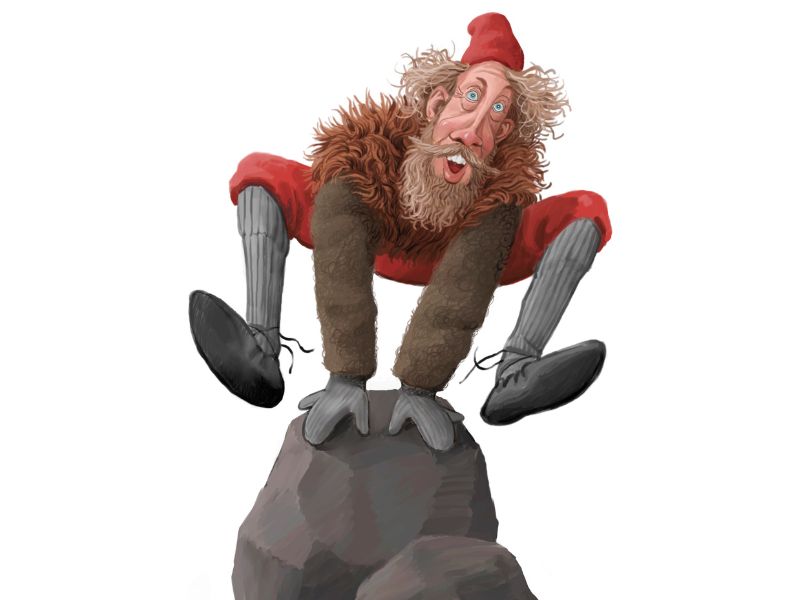
2. Giljagaur (Gully Gawk) – December 13
His brother Giljagaur (Gully Gawk or Crevice Imp) arrived next, hiding in gullies and ravines near farms, waiting for his chance to strike. This sneaky character had a penchant for stealing cream and milk from the cowshed. He would lurk in ditches and crevices – hence the name – watching for the moment when the farmer’s back was turned. Then he’d creep into the cowshed and help himself to the cream that rose to the top of fresh milk. In a time when butter and skyr (made from this precious cream) were among the few luxuries poor Icelandic farmers enjoyed at Christmas, Giljagaur’s thefts were particularly cruel. The cream he stole represented hours of careful dairy work and was often saved for weeks to make special Christmas treats. Finding your cream stolen by this gully-dwelling pest must have been infuriating.
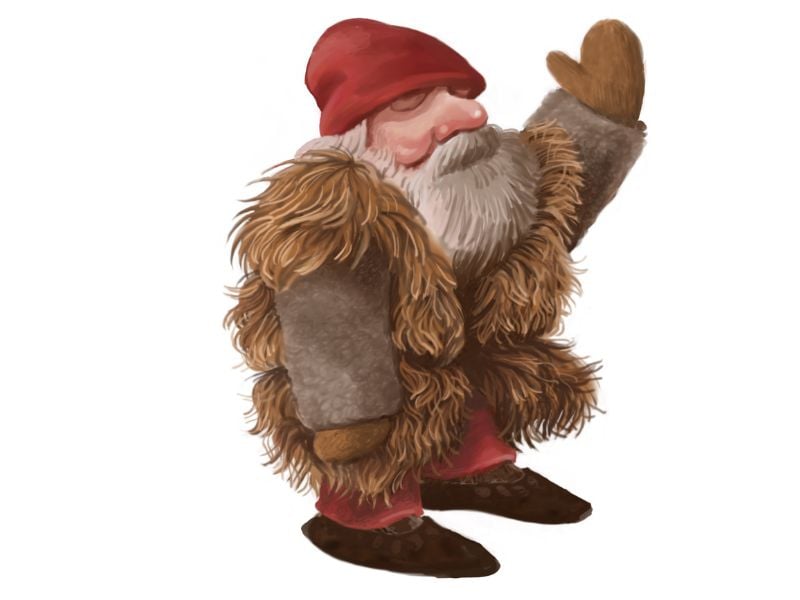
3. Stúfur (Stubby) – December 14
The dwarf-sized Stúfur (Stubby or Itty Bitty) was the third to arrive. Despite being abnormally short – even for a troll – this fellow was surprisingly nimble. He had a thing for the burnt morsels of food that stuck to pots and pans. Now, you might think, “What’s the harm in that? He’s just cleaning up the scraps!” But here’s the thing: in the Iceland of old, even those burnt bits were valuable. Nothing went to waste when food was scarce. Those charred pieces stuck to pans would be scraped off, ground down, and used to augment food. More importantly, Stúfur’s small size allowed him to sneak around kitchens undetected. His presence meant he was rummaging through your cooking area, making a mess, and generally being a nuisance right when Christmas preparations were at their busiest. Plus, his particular vice revealed just how desperate and strange these Yule lads were – imagine being so troublesome that you’d break into someone’s home just to lick their dirty pots!

The emaciated Þvörusleikir (Spoon Licker) would sneak into Icelandic kitchens to lick every wooden spoon he could find during Christmas preparations. Art by Ólafur Pétursson.
4. Þvörusleikir (Spoon Licker) – December 15
Number four was Þvörusleikir (Spoon Licker or Pot Scraper Licker), who licked wooden spoons whenever he could, which is not a hygienic practice at all. This lanky, thin fellow was emaciated from living on nothing but what he could lick from spoons. In Icelandic farmhouses, wooden spoons – ‘þvörur’ – were valuable kitchen implements that were reused constantly. Þvörusleikir would sneak into kitchens and lick every spoon he could find, leaving them covered in troll saliva. During the hectic Christmas season, when Icelandic families were already working overtime to prepare enough food for the darkest days of winter, this spoon-licking menace added insult to injury. The image of this gaunt troll hiding in corners, desperately licking spoons, is deeply unsettling.
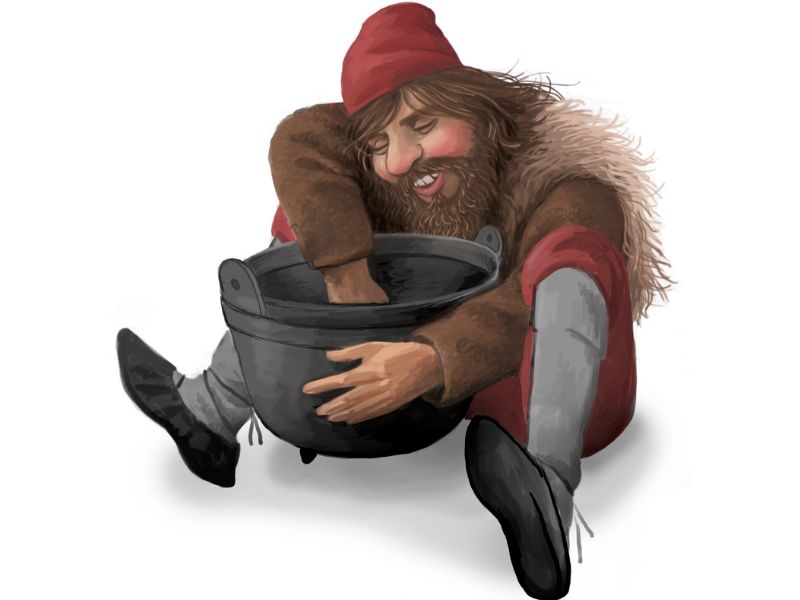
5. Pottaskefill (Pot Scraper) – December 16
Criminal number five was Pottaskefill (Pot Scraper or Pot Licker). He would make a lot of noise to create diversions, allowing him to raid the kitchen undisturbed. This clever troll was a bit more sophisticated in his approach than his brothers. He’d bang pots, rattle pans, and knock things over in one part of the farm. While everyone rushed to investigate the commotion, he’d sneak into the kitchen and scrape clean every pot he could find with his favorite tool – a pot scraper. The food residue clinging to cooking pots was, again, precious in old Iceland. Those scrapings would be saved and reused. But more than the food value, imagine the frustration of spending hours cooking a special Christmas meal, setting the pot aside to serve later, and finding it licked clean by this noisy troublemaker. Pottaskefill represents a particular kind of criminal cunning. He wasn’t just a thief; he was a con artist who used distraction and chaos to cover his crimes.
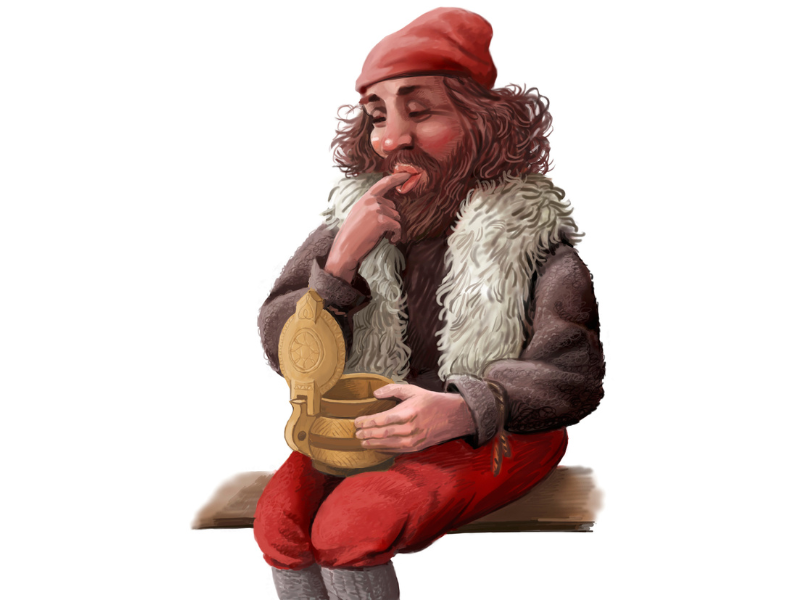
6. Askasleikir (Bowl Licker) – December 17
Number six was Askasleikir (Bowl Licker), who specialized in stealing food from people’s bowls and dishes. This Yule lad was particularly sneaky and patient. In traditional Icelandic homes, wooden bowls – ‘askar’ – were used for eating, and families would sometimes set their bowls down under beds or in cupboards, planning to finish their meals later. Askasleikir would wait in hiding, silent as the grave, until everyone left the room or fell asleep. Then he’d creep out and lick every bowl clean, leaving nothing but his revolting troll spit behind. This was a deeply personal violation. This was your food, your bowl, your next meal – gone. For children who had saved half their porridge for later, or adults who had carefully rationed their Christmas treat, finding their bowl licked clean by this patient predator must have been heartbreaking. Yet again, poor people have their precious food stolen by these relentless trolls.

7. Hurðaskellir (Door Slammer) – December 18
The Yule villain number seven is Hurðaskellir (Door Slammer). He would lurk around the farms on dark December nights, slam doors, and wake everybody up. What a nuisance. But this wasn’t just about being annoying – though he certainly excelled at that. In the Icelandic winter, with howling winds and bitter cold, doors were kept carefully closed and latched to preserve precious warmth from the fire. When Hurðaskellir went on his door-slamming rampages, he’d let all the heat escape. This would plunge the household into freezing cold just as everyone was trying to sleep. Even worse, in the pitch-black Icelandic winter night – we’re talking about complete darkness during December – the sound of doors violently slamming would terrify everyone awake. Was it the wind? A troll? An avalanche about to hit? People would jolt awake in panic, hearts racing, only to realize it was this miserable creature playing his cruel games. Sleep deprivation was no joke when you had a full day of brutal farm work ahead of you.
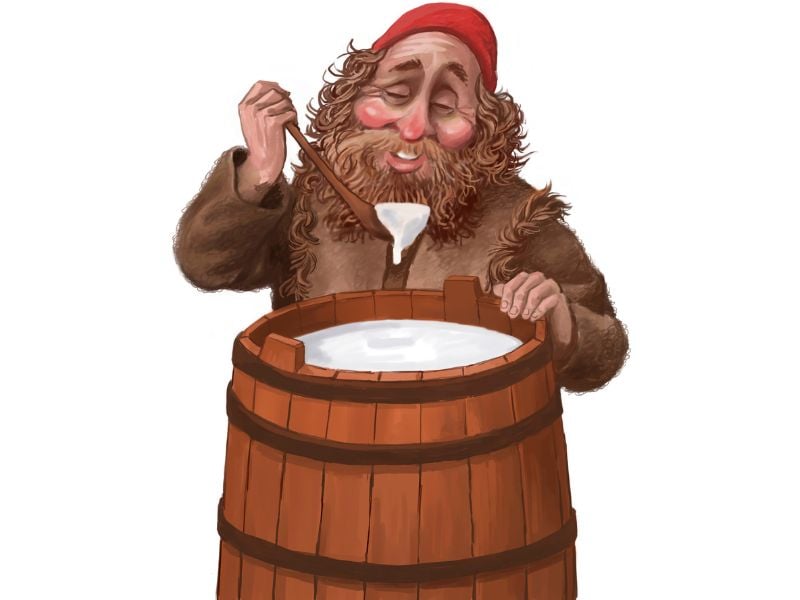
8. Skyrjarmur (Skyr Gobbler) – December 19
Number eight was Skyrjarmur (Skyr Gobbler), who would break open barrels full of Skyr and go on a Skyr binge! What is Skyr, you ask? Well, technically, it is a form of cheese – a cultured dairy product similar to yogurt that’s been a staple of Icelandic cuisine for over a thousand years. In the old days, skyr was serious business. Families would spend the summer and fall carefully preparing barrels of skyr to sustain them through winter. It was a critical source of protein and calories when fresh food was scarce. A single barrel represented months of dairy work – milking, culturing, straining. When Skyrjarmur broke into your storage and gorged himself on your winter supply of skyr, he wasn’t just being gluttonous. He was threatening your family’s survival. This greedy troll would eat until he was nearly bursting, leaving sticky, sour destruction in his wake. The image of him with his face buried in a barrel, scooping out handfuls of precious skyr while your children’s winter food supply dwindled, made him one of the more truly despicable Yule lads.
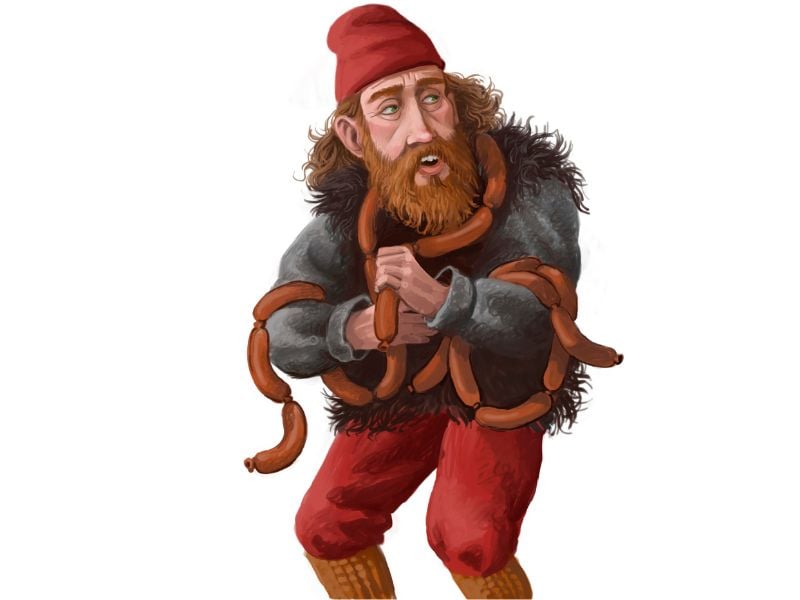
9. Bjúgnakrækir (Sausage Swiper) – December 20
Bjúgnakrækir (Sausage Swiper or Sausage Snatcher) would steal sausages – and this was perhaps the cruelest theft of all. Sausages in traditional Iceland represented the absolute pinnacle of Christmas preparation. After sheep were slaughtered in the fall, every part of the animal was carefully preserved. The blood, fat, and organ meats were painstakingly mixed with suet and grain, stuffed into intestines, and hung in the rafters to smoke. These sausages – blood sausage, liver sausage – were the Christmas feast. They were what made the holiday special after months of eating just dried fish and porridge. This troll would hide up in the rafters where sausages hung, using his specialized hook to snatch them down one by one. Can you imagine working for months to prepare your Christmas sausages, looking forward to that one special meal that would break the monotony of winter, only to find this hook-handed villain had stolen them all? Bjúgnakrækir didn’t just steal food; he stole joy itself.

10. Gluggagægir (Window Peeper) – December 21
The sexual deviant in the bunch was Gluggagægir (Window Peeper or Peeping Tom). He would do what peeping toms do. This creepy character represents a different kind of violation than the food thieves. In Iceland’s long, dark winter nights, windows were rare and precious. Windows let in what little light there was and provided a connection to the outside world. But they also made families vulnerable to prying eyes. Gluggagægir would creep around farms in the darkness, pressing his face against windows to spy on families inside. He was particularly interested in looking for things to steal, but the invasion of privacy was deeply unsettling. Imagine being in your home, one of the only safe spaces in a harsh and dangerous world, and seeing a troll’s face pressed against your window in the darkness. Mothers would keep children away from windows when Gluggagægir was due to arrive. This wasn’t just about theft – this was about fear, vulnerability, and the violation of your home’s sanctity.

11. Gáttaþefur (Doorway Sniffer) – December 22
Number eleven was Gáttaþefur (Doorway Sniffer), who had an abnormally large nose and an extremely sensitive sense of smell. This unpleasant fellow would use his enormous schnoz to sniff out laufabrauð – the traditional Icelandic Christmas bread. Laufabrauð, or “leaf bread,” is a wafer-thin, deep-fried flatbread decorated with intricate carved patterns. It’s a lot of work to make. You roll the dough paper-thin, carve beautiful designs with a special knife. Then you carefully fry each piece to golden perfection. I love those; there is no Christmas without them. Gáttaþefur would stick his massive nose into doorways, sniffing and sniffing until he located every piece of laufabrauð in the house. Then he’d steal them all, leaving families without this cherished Christmas tradition. Imagine the disappointment of having this treat stolen on Christmas – treats that represented hours of careful, artistic work. The image of this big-nosed troll going from door to door, his ridiculous nose twitching as he tracked down your Christmas bread, is both comical and infuriating.
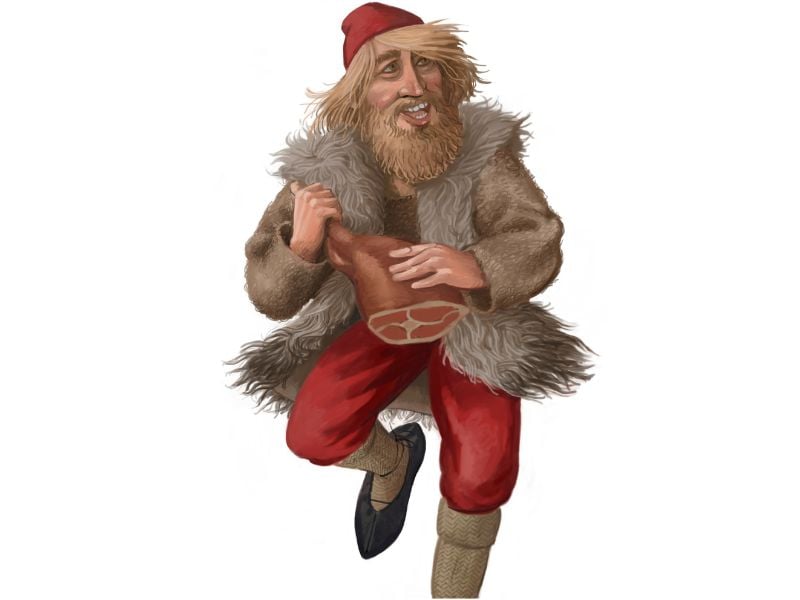
12. Ketkrókur (Meat Hook) – December 23
The final two arrive in the days leading up to Christmas. Ketkrókur (Meat Hook) arrived on December 23rd, just two days before Christmas, to steal meat stored away for the holiday feast. This timing was absolutely diabolical. By late December, families had their precious Christmas meat – smoked lamb, maybe some salted beef if they were lucky – hanging in storage, almost ready for the big feast. They’d been protecting it, saving it, looking forward to it for months. Then this troll would show up with his long, hooked pole, snatch the meat down, and disappear into the night. The meat he stole wasn’t just food; it was the centerpiece of Christmas dinner, the special meal that made all the hardship worthwhile. Losing your Christmas meat two days before the holiday, after all that preparation and anticipation, must have been absolutely devastating. Ketkrókur was a creep who knew exactly how to inflict maximum disappointment, and his late arrival meant he was often the final blow to a family’s Christmas hopes.
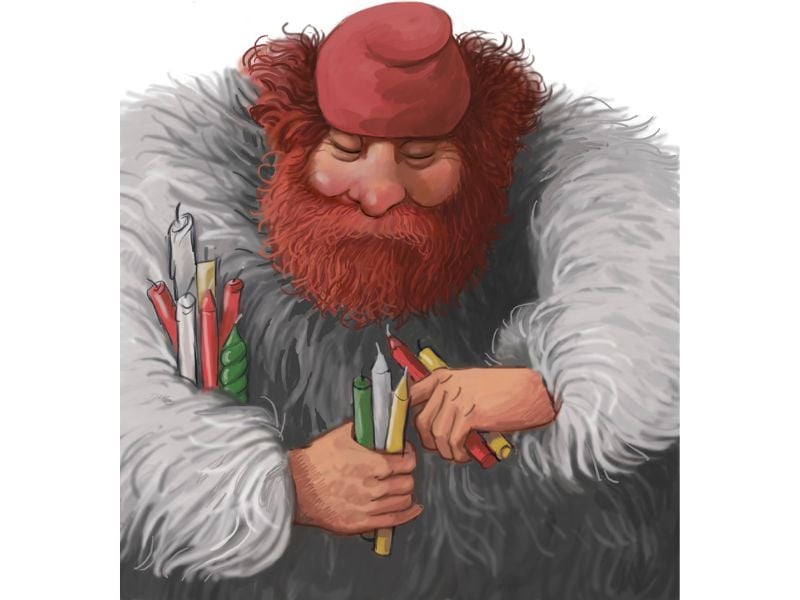
13. Kertasníkir (Candle Beggar) – December 24
Kertasníkir (Candle Beggar or Candle Stealer) was the last to arrive. He showed up on Christmas Eve itself to steal candles from children. A hideous crime on Christmas night. In historical Iceland, candles were incredibly valuable. They were often made from sheep tallow, which meant sacrificing precious fat that could have been used for food. Children who received their own candle for Christmas were getting a genuine treasure. They were a source of light and warmth in the endless winter darkness. Candles represented hope, celebration, and the light that would eventually return after the winter solstice. Kertasníkir would specifically target children’s candles. He would follow them around and snatch the candles right from their hands to eat the tallow. The image of children crying on Christmas Eve because this greedy troll stole their one special gift is genuinely heartbreaking. He was called a “beggar,” but he was really a thief. His crime was all the more cruel because he attacked on Christmas Eve itself, the holiest night of the year.
Icelandic Yule lads have mended their ways for a better Icelandic Christmas
These days, Yule lads are considered to be the friends of children. Now, Icelandic children put their shoes in the window during the thirteen nights before Christmas. The Yule lads obligingly give them small presents and place them in the shoe overnight – unless they have been naughty. In that case, they get a potato, which is not a bad gift if you think about it. Each lad arrives on his traditional night (starting December 12th with Stekkjastaur), stays for thirteen days, and leaves the day after Christmas, maintaining the old schedule but now bringing joy instead of terror.
And what happened to their awful mother, Grýla? A popular Icelandic Christmas song claims that she is long dead. However, she still appears at festivals and events before Christmas but claims to be nice now. I am not so sure. That is what she would say, right? And that Christmas Cat might still be out there, prowling for people without new clothes…
The transformation of these characters from terrifying trolls to beloved gift-givers reflects Iceland’s own transformation from a place of desperate poverty to a modern, prosperous nation. We can afford to laugh at these once-frightening creatures because we no longer live in fear of starvation and cold. But the stories remain, reminding us of harder times and the resilience of our ancestors who survived them.
The names and descriptions of the Icelandic Yule lads are based on a poem by the Icelandic poet Jóhannes frá Kötlum (1899-1972). Jóhannes helped standardize the thirteen Yule lads we know today.



